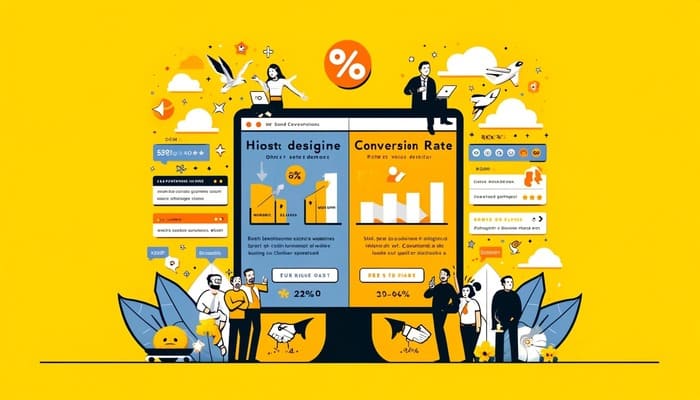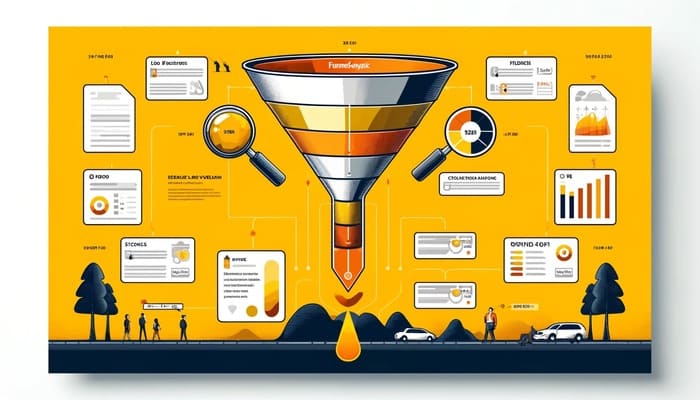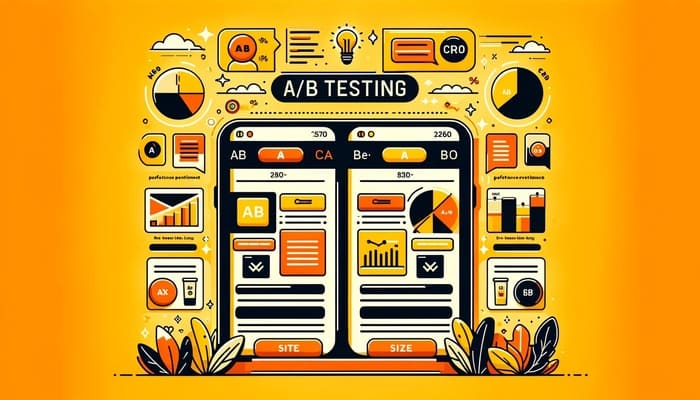Explore the chapters:
Whether you’re running an ecommerce website, overseeing online marketing efforts, or managing SEO strategies, conversions play a pivotal role in driving business success. Conversion Rate Optimization (CRO) practices are essential for maximizing your potential to attract and retain customers.
In this comprehensive guide, we’ll explore CRO best practices to consistently improve your conversion rates.

Conversion Rate Optimization (CRO) revolves around enhancing the percentage of website users who take a desired action. These actions, termed conversions, may encompass activities like purchasing a product, clicking ‘add to cart,’ or completing a form. Effective CRO strategies prioritize optimizing the customer experience to boost conversions.

A conversion rate represents the proportion of visitors who perform a desired action on a website, such as submitting a web form, registering for a service, or buying a product.
A high conversion rate suggests that your website is well-crafted, structured efficiently, and resonates with your intended audience. Conversely, a low conversion rate may stem from various factors related to website performance or design.
Common causes of a low conversion rate include sluggish loading times, malfunctioning forms, or the copy that fails to communicate the value of the offer effectively. Addressing these issues can help improve conversion rates and enhance overall website performance.
Calculating conversion rate:
The conversion rate is calculated by dividing the number of desired actions by the total visitors multiplied by 100.
If your desired actions are email opt-ins, the conversion rate is the number of email opt-ins divided by all visitors multiplied by 100.
If your desired actions are product sales, the conversion rate is the number of sales divided by the total number of visitors multiplied by 100.
Here are four key website areas to implement Conversion Rate Optimization (CRO):
Homepage:
The homepage serves as a crucial entry point for visitors. Enhance its effectiveness by featuring prominent links to product information, offering a free signup option, or integrating a chatbot for immediate assistance.
Pricing Page:
A well-optimized pricing page can significantly impact conversions. Experiment with pricing intervals, detailed product feature descriptions, or adding a phone number for personalized assistance. Simple additions like email opt-in popups can yield substantial lead generation results.
Blog:
Blogs offer vast conversion potential. Integrate strategic calls-to-action (CTAs) within articles, inviting readers to engage further by exchanging their email for valuable resources like ebooks or industry reports.
Landing Pages:
Landing pages, tailored for action, boast the highest average conversion rates. Optimize event pages with engaging videos or provide sneak peeks of free resources to incentivize registrations and downloads.
By optimizing these areas, you’ll effectively steer visitors towards conversion actions. But how do you know when it’s time to kickstart your CRO efforts? The starting point to conversion rate optimization is defining the areas you want to focus on. Let’s explore the different CRO formulas to understand where you should start
Our goal is always tied to improvement in conversion actions from the specific number of people who visit the conversion page. The CRO process starts the moment you understand the areas of improvement.
We shared three commonly used formulas to calculate conversion rate optimisation to analyse and optimize.
As we previously mentioned, calculating your conversion rate involves dividing the number of conversions (or leads generated) by the total number of visitors (or web traffic), then multiplying by 100 to obtain the percentage.
Conversion Rate (%) = (Leads Generated ÷ Website Traffic) x 100
To determine the number of net new customers required to achieve your revenue goal, divide your net revenue target by the average sales price.
Number of New Customers = New Revenue Goal ÷ Average Sales Price
To calculate your lead goal, divide the number of new customers by the lead-to-customer close rate percentage.
Lead Goal = Number of New Customers ÷ Lead-to-Customer Close Rate %
Out of these available options, based on your business goal, you can select a goal and get started with the CRO process. But which strategy you should follow to meet your goals? Out of all the available strategies, as our goal is to make our ideal customer take a specific action, we highly recommend focusing on the customer-centric CRO strategy.
Understanding your customers and leveraging insights to develop an optimization strategy is crucial for successful Conversion Rate Optimization (CRO). We delve into practical methods to achieve this. However, for now, let’s explore the steps needed to achieve this goal.

Conversions, representing the desired actions you aim for users to take, vary across businesses and goals. For an e-commerce site, a conversion might entail a completed purchase, while for a Software-as-a-Service (SaaS) company, it could be signing up for a free trial.
Once you pinpoint the desired action to target, the focus shifts to optimizing the rate at which visitors fulfil that action—commonly referred to as your ‘conversion rate’.
Conversion Rate (%) = (Number of Conversions ÷ Number of Visitors) x 100

Closely inspect every page of your conversion funnel to understand factors causing visitors to leave without completing the desired action. This process is known as funnel analysis.
You can track your conversion rate manually and identify drop-off points using a heatmaps tool like Microsoft Clarity. This tool visualizes how traffic moves through your site, making it easier to spot areas where visitors exit and understand why.

Once you’ve identified key drop-off points in your funnel, it’s crucial to gather as much information about your users as possible. This step is arguably the most critical aspect of any user-centric Conversion Rate Optimization (CRO) strategy. Not every obstacle to conversion is quantifiable or straightforward.
While some issues may stem from a single bug preventing the majority of users from completing a desired action, others may not be as clear-cut. Sometimes, even with a perfectly functioning website, users may still fail to convert. In such cases, it’s essential to delve deeper into the underlying reasons behind the data and focus on addressing users’ needs—this is the essence of CRO.
While the ultimate goal is to drive conversions, it’s essential to recognize that a lot happens before reaching that point:
Specific incentives or hooks persuade them to convert: Consult your existing customers to learn what convinced them to convert and what almost stopped them. This feedback provides valuable insights into improving your conversion funnel.

The next step is about using insights from collected data to form hypotheses. These hypotheses guide decisions on adding, adjusting, or removing funnel features to boost conversions.
While analyzing vast data might seem overwhelming, the next step—testing hypotheses—helps validate changes. Through trial and error, you’ll identify impactful adjustments in an iterative CRO process.

Now, it’s time to test your hypotheses and implement data-driven optimizations to boost conversions. In CRO tests, it’s crucial to blend quantitative and qualitative metrics: quantitative metrics reveal “what” changes lead to improvements, while qualitative metrics explain “why.”
A/B testing different variants of web pages is an effective method for experimenting with new UX designs and sales funnel flows.

In the final and ongoing step, review the impact of your tested changes on the conversion rate. As you iterate, conversion rates will improve incrementally. Continuously monitor your conversion rate and identify areas for improvement with an ongoing CRO program.
Who doesn’t want to explore the best practices of different things in marketing? You might have encountered ‘best practice’ lists for CRO too that promise a spike in conversions. However, what works for one might not work for another. So, we have compiled a list of best practices and tips you can consider to test which is going to improve your conversions.
Audience understanding is the foundation of conversion rate optimization. It enables tailoring messaging to address their pain points and needs effectively.
Go to your analytics and search console to understand the demographics of your audience. It will help you to further deepen your research to understand them better and tailor your messaging accordingly.
You can gain insights into your existing customers by conducting surveys, offering immediate feedback about your website.
Implement a brief survey that pops up as a customer is about to leave your site or sends to their email along with their purchase confirmation.
Survey responses can shed light on why a customer left without converting, aiding in identifying areas for improvement.
To encourage more visitors to complete your survey, keep it short and straightforward. You can prompt them with “Take this one-minute survey,” ensuring you respect their time.
To boost conversions, ensure your webpages align with your audience’s expectations. Consider how they reached the page you’re optimizing.
For users arriving from ads, provide a landing page consistent with the ad’s promise. For instance, if an ad offers a 50% discount on a product, ensure the landing page prominently displays the product and discount. Any inconsistency may lead to confusion and visitor abandonment.
For pages targeting organic traffic through keywords, prioritize meeting search intent.
Utilizing A/B testing, or split testing, enables you to swiftly discern what drives conversions on your website.
A/B testing involves comparing two versions of a webpage, each differing by a single element, such as a headline or call to action (CTA).
For instance, you might compare a subheading with broader appeal to one tailored for working parents. Or, you could test whether reducing the number of form fields boosts submissions.
Elements you can test:
Implementing calls to action (CTAs) in various forms and locations across your pages can enhance visitor conversion rates.
For instance, while blog posts commonly feature a CTA in the conclusion, this may overlook potential conversions from users who don’t read the entire page. Additionally, CTA banners may sometimes go unnoticed if they resemble ads.
However, by employing a mix of CTA buttons, in-text CTAs, banners, and other forms, you provide users with multiple opportunities to convert.
It’s crucial to have one prominent call to action (CTA) on your page, minimizing distractions for optimal conversion chances.
Consider a landing page aimed at driving demos. The primary goal is to encourage users to book a demo. However, including other links like a navigation bar may divert users’ attention from this desired action.
By removing distractions such as the navigation, you maintain focus on the desired action, increasing the likelihood of conversion.
Schedule a free consultation call with our team today
Here are a few of the best tools to help you carry out the conversion rate optimization process and measure your efforts:
We have categorized these tools based on the purpose as below:
Let’s start with lead capture tools
You will use these tools to capture more leads on your site, thus improving your CRO analytics.
While most conversion-focused content has a built-in form or call-to-action (CTA), these tools act as additional lead capture mechanisms to boost the number of leads that convert on your content.
HubSpot offers a blend of Google Analytics, SumoMe, and a CRM. It initiates with an exit intent pop-up CTA, then integrates with your website’s existing forms to understand your visitors and their journey.
With HubSpot’s suite, you gain deep insights into your prospects and existing contacts.
Its contacts database is complemented by a dashboard showcasing the effectiveness of your marketing efforts.
Why we like it: HubSpot is an encompassing solution for customer conversion and nurturing. Its CTA Tool empowers the quick creation of lead conversion points.
HelloBar is a lead capture tool enabling the addition of a pop-up form to your website for email list expansion, social page promotion, sale showcasing, and other lead generation tactics.
The free version offers one modal displayed to every 10th visitor, while premium plans provide advanced CTA options. Pop-up styles include bars, modals, alerts, sliders, and full-page takeovers.
Why we like it: Hello Bar offers practical, user-friendly pop-ups with analytics and optimization capabilities.
Bdow, formerly Sumo, provides a collection of free tools to enhance site conversions. Its offerings include a “Welcome Mat” pop-up CTA, a “Smart Bar” for boosting email subscribers, a scroll-triggered box, and a “Contact Us” form.
Combined with Google Analytics research tools, Sumo’s suite aids in on-page insights and email list expansion.
Ideal for: Small to medium-sized ecommerce businesses seeking a comprehensive set of CRO tools.
Picreel is a versatile tool for optimizing conversion rates by capturing leads and maximizing conversions through engaging pop-ups.
Its exit-intent technology targets visitors about to leave with attractive offers, persuading them to share their contact details.
Data collected is seamlessly integrated with your CRM, enabling lead nurturing and conversion.
Exit overlays can include personalized messages based on visitors’ click behavior and past purchases.
Highlighted feature: Picreel integrates with popular CRMs like HubSpot and Salesforce, as well as email marketing platforms like MailChimp and Adobe Marketo Engage.
Before creating content, turn to these tools for inspiration and insights from successful marketers.
BuzzSumo compiles the most shared and linked content on any given topic, offering valuable insights for content marketers. Simply enter a keyword or topic, and BuzzSumo presents the top-performing articles, resources, videos, and more. With additional features like keyword tools and trend analysis, BuzzSumo is a powerful tool for staying ahead of the competition.
SimilarWeb provides valuable insights into website traffic sources, organic keywords, and competitor performance. By understanding where your traffic comes from, you can optimize your content and marketing strategies accordingly. With detailed analytics and comparison features, SimilarWeb is ideal for teams seeking comprehensive digital traffic data to inform their optimization efforts.
Land-book offers a curated selection of professionally designed landing pages, making it easier to create your own effective page. By exploring how top companies utilize copy, layout, and design elements to drive conversions, you can gain valuable inspiration for your own landing page. With filters for various page types and styles, Land-book allows you to find examples that align with your preferences and industry.
Really Good Emails serves as a valuable resource for email marketers and designers seeking inspiration for their campaigns. This database showcases well-designed emails from innovative companies, providing insights into effective visual communication and design strategies. By exploring examples of successful email designs, you can learn how to effectively convey your message and capture your audience’s attention. Whether you’re crafting a promotional campaign or a newsletter, Really Good Emails offers a wealth of inspiration to enhance your email marketing efforts.
SubjectLine.com offers a valuable tool for email marketers seeking to optimize their subject lines for maximum impact. With over 15 million subject lines tested, this resource provides insights into which options are most likely to drive engagement. By evaluating subject lines based on deliverability and marketing scores, as well as offering advice for improvement, SubjectLine.com empowers marketers to make informed decisions about their email campaigns. Additionally, the integration with ChatGPT allows users to leverage AI to generate compelling subject lines, making it a useful resource for overcoming writer’s block and enhancing email performance.
CoSchedule’s headline analyzer offers a score from 1 to 100 to evaluate the effectiveness of titles by considering word usage, grammar, vocabulary, headline type, and character and word count. It provides previews of how your headline will appear on Google and in an email subject line, serving as a valuable litmus test for headline performance. For optimal results, consider using both CoSchedule and Attrock’s headline analyzer tools to refine your headlines effectively.
Utilize these tools to measure and track your content’s performance over time. Employing CRO analytics enables you to thoroughly analyze fluctuations, dips, and spikes in your conversion rate.
Kissmetrics is a robust analytics tool that sheds light on user behavior on your website, empowering you to utilize this data to boost revenue. With Kissmetrics, you gain insights into your customers’ journey on your site, conduct A/B tests, create data sets (without SQL), optimize website conversions, and evaluate campaign ROI. Its user-friendly interface makes it accessible for non-technical teams to leverage insights and drive conversions.
Google Analytics offers a cost-effective way to monitor website traffic, providing insights into visitor behavior, bounce rates, goal completions, and traffic sources. It enables you to track keyword performance, device usage, and demographic data. While it lacks specific user contact information, its free tools are highly valuable for most teams. Google Analytics 360, its premium version, is recommended for larger enterprises due to its cost.
HubSpot Website Grader provides a comprehensive overview of a website’s performance, assessing factors such as speed, mobile responsiveness, SEO, and security. It generates a grade and offers actionable suggestions for improvement, making it valuable for website conversion optimization. HubSpot’s tool stands out for its user-friendly interface and actionable insights.
You can leverage these tools to understand user interaction with your content, such as scrolling behavior and click patterns.
Once you’ve mastered the fundamentals, such as landing pages, CTAs, pop-ups, and content, you can advance to more sophisticated conversion rate optimization techniques.
Hotjar provides heatmaps and screen recordings, allowing you to monitor page visibility and visitor navigation on your website.
Additionally, Hotjar offers analytics to assess the effectiveness of your pages. This insight helps you identify areas for improvement and optimize for higher conversions.
Pro tip: Utilize heatmaps to visualize user interactions, informing strategic placement of conversion elements in high-engagement areas.
Website design and conversion rate optimization hinge entirely on understanding your target audience. Mouseflow allows you to pinpoint where users engage or drop off on your site, highlighting areas of frustration.
In addition to conversion funnels and session replay, Mouseflow provides a comprehensive suite of tools, including heatmaps, form analytics, and feedback.
By leveraging these tools, you gain deeper insights into your visitors’ behavior and can make informed changes to enhance your conversion rate.
What stands out: The Friction Score feature swiftly identifies user frustration, enabling you to enhance user experience (UX), refine user interface (UI), and ultimately boost conversions.
Contentsquare (formerly Clicktale) operates similarly to Hotjar, providing a suite of tools to enhance website optimization.
Its heat maps reveal the most valuable areas of your pages, while scroll depth analysis identifies where the “fold” lies on your website. Additionally, it tracks clicks, analyzes links, and offers AI-powered insights with automatic alerts and recommendations.
By leveraging these tools, you gain valuable insights to organize content, CTAs, and page design for optimal engagement.
Ideal for: Organizations seeking to enhance user experience and drive improvements on their website.
Microsoft Clarity is a free tool that uses heatmaps and session recordings to help website owners understand how visitors interact with their webpages. It helps improve user experience and identify website issues.
Clicky provides real-time analytics on your website visitors, offering insights into their access points, page durations, and current online presence. It also includes heat maps and scroll tracking features.
With Clicky, you gain a comprehensive understanding of customer behavior, allowing you to optimize your website’s performance for maximum lead conversion.
A standout feature is Clicky’s Spy tool, which delivers a live stream of visitor activity, enabling instant monitoring of website interactions.
Ideal for: Businesses seeking real-time insights to enhance website performance and increase lead conversions.
Crazy Egg provides a comprehensive suite of heat maps and click tracking tools, allowing you to segment clicks by source and assess link effectiveness. With an affordable basic package, it offers significant insights into the effectiveness of each webpage.
Ideal for: Companies prioritizing user-friendly interfaces in their website and conversion rate optimization tools.
Heatmap.com is a tool focused on heat mapping and analytics, aimed at enhancing your website’s usability with actionable insights. It provides real-time analytics to highlight areas of user attention and frustration, enabling proactive adjustments.
Best for: Those seeking AI-modeled features to identify Revenue Drivers and Conversion Killers for immediate action.
You’ll employ these tools to engage with and gather feedback from your visitors effectively. These feedback mechanisms encompass surveys, polls, messaging systems, and user testing programs.
Intercom stands out as a popular conversion platform enabling direct communication with website visitors via easily integrated and visually appealing pop-up chat windows. As a CRO analytics tool, Intercom facilitates communication with website prospects, enabling you to gauge their needs, assess their experience, and identify areas for improvement. Additionally, it offers lead tracking and a shared inbox feature for streamlined team collaboration.
Ideal for: Teams seeking more direct engagement with their website visitors.
Qualaroo offers a robust user feedback tool allowing you to deploy chat windows and targeted questionnaires directly within your website or mobile app. It’s valuable across various funnel stages and is particularly useful in ecommerce settings. With advanced targeting capabilities, Qualaroo ensures you ask the right questions to the right users at the opportune moment, crucial for CRO success. Additional features such as branching logic, design customization, and sentiment analysis powered by its IBM Watson integration enhance its usability.
Ideal for: Businesses aiming to harness qualitative insights and user feedback for optimizing conversions.
SurveyMonkey is a leading survey software solution, offering user-friendly tools for creating, deploying, analyzing, and managing custom surveys. It’s invaluable for gathering qualitative customer data to guide decisions on web page design, copy, user experience, and beyond. One standout feature is its skip-logic capability, which enables customization of surveys based on respondents’ previous answers, ensuring relevant questions are asked and enhancing CRO efforts.
Ideal for: Businesses seeking to gather qualitative insights for optimizing website performance and conversions.
Lyssna (formerly UsabilityHub) provides a comprehensive suite of creative tools designed to illuminate the user experience of your website, offering invaluable insights for CRO initiatives. From navigation tests and funnel visualizations to heat maps and first-click testing, UsabilityHub empowers organizations to delve deep into usability research and optimize conversions effectively. A standout feature is their Five Second Test tool, which aids in understanding users’ initial impressions of your site—a crucial aspect of successful CRO efforts.
Ideal for: Organizations seeking in-depth usability research to enhance website performance and drive conversions.
Here are some tools that will assist you in managing, planning, and executing A/B and multivariate tests:
Optimizely simplifies testing by providing support for experiments across devices and platforms. It offers A/B, multiple-page, and multivariate tests, helping you determine statistical significance for reliable results. With Optimizely, you can focus on optimizing conversion rates without the hassle of complex setup and analysis.
Optimizely’s software provides comprehensive test results reports, allowing you to evaluate the impact of changes on conversions. It’s ideal for businesses prioritizing experimentation and data-informed decision-making.
Effective Experiments offers a centralized space for your CRO experimentation efforts. If you have tons of Excel spreadsheets cross-referenced with Google Analytics data, you’re probably going crazy trying to keep track of everything.
This tool puts it all together and helps you determine statistical significance.
Best for: CRO teams looking to consolidate insights across multiple tools into a single, easy-to-use platform
Absolutely! Every website visit holds potential, and CRO tactics can unlock that potential into tangible benefits. Starting with understanding your audience is crucial. Consider using the tools we listed and strategies we outlined to gather the necessary data and kickstart your CRO journey.
Ever wondered how you can streamline your data management but also build stronger customer relationships and drive tangible results? In the next chapter, we dive into the essentials of CRM integration, showing you how to elevate your CRM efforts to new heights. Get ready to see how effective CRM integration can enhance your business operations and boost your customer engagement.
638 Independence Parkway, Suite 240, Chesapeake, Virginia, USA – 23320
3 Eurospace, 4th Floor, Jyothi Imperial, Janardana Hills, Gachibowli, Hyderabad, Telangana, India – 500032
Mileta Sorokovska, Moosstrasse 19,
6003 Luzern, Switzerland
Copyright © 2024 by StartupWize